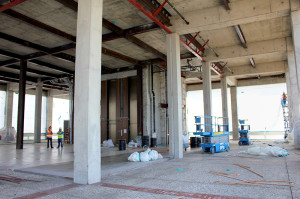August Date Likely for Warren Hall Demolition

elevator and campus vault.
The iconic 13-story building staring down at thousands of East Bay residents is going out with a bang.
Warren Hall, located on CSU East Bay’s Hayward campus, is set to implode this summer with speculation still surrounding the exact date.
“We are constantly talking about the schedule and as of today it is coming down on the 18th of August,” said Sheryl Boykins, CSUEB’s new university police chief elected in April.
Jim Zavagno, associate vice president of Facilities, Development and Operations said they will formally announce the date when it is set in stone and that things may change due to weather conditions such as cloud coverage and wind. He added, “implosions are not as simple” as they seem.
“There’s a real science to where you want to place [charges], you want to use as little explosives as possible,” added Zavagno. “Basically you want the building to fall on itself and take itself down.”
California voters passed the Statewide School Repair and Construction Bond Act in 2004, which allocated more than $30 million to retrofit the structure, according to a CSUEB news article.
Yet, the plans to seismically fit the building turned into a larger project when the CSU board of trustees announced Warren Hall is the least seismically fit building on any of the 23 California State University campuses. The CSU board of trustees earmarked $50 million to the complete removal and replacement of Warren Hall early this year.
Currently, the roughly $9-$12 million demolition project is going well, said Zavagno.
“We did a pretty good job investigating ahead of time what we were going to face. So, we don’t like surprises when it comes to this,” he said.
Huntsman Architectural Group, located in San Francisco, mitigated the area and provided estimations for the abatement process, which is the removal of hazardous materials such as asbestos, of the 140,000 gross square foot structure, said the facilities manager.
Sundt Connections, whose central headquarters is located in Tempe, Arizona, is currently managing the construction site, Zavagno noted. He said the university hired Sundt and Huntsman after undergoing a strict mandatory legal process through the CSU board of trustees.
“It is [Sundt’s] responsibility to demolish and remove all the hazardous material “in the abatement process,” Zavagno added.
As of now, Sundt is finishing up abatement on the top floor and in the basement, along with the last touches to the lower floor of the bridge according to Zavagno. After, the bottom floor of the bridge is abated, Sundt will remove the bridge.
The abatement to the bridge is posing a problem for university police, according to Boykins, who says dispatch calls are difficult to hear due to the jackhammering nearby. She says her main concern “is getting the dispatch center taken care of and getting the police department in a way that [they] can still function.”
“We are going to move [dispatch] to Hayward PD, the 911 calls will be dispatched there,” said the new police chief. “And then, the other campus emergency calls and call boxes will be dispatched out of The Pioneer,” located in Meiklejohn Hall.
She says this move will take place a couple weeks before implosion, and added the process may keep them out of their offices for up to eight weeks.
Boykins says she is communicating with Caltrans and local police departments to spread the word. She also expressed concerns regarding traffic on 880 and people who may think of this “as a terrorist attack or natural disaster.”
In addition, she said the university police would do as much as they can to inform the public and that nearby neighbors should expect concrete dust to float into their yards.
The university police together with the Hayward Police Department will create a border around the university the day of the implosion, to prevent people from getting to the construction site. In addition, they will vacate all nearby buildings.
Zavagno says they have put aside subsidies in case they run into problems and added that total costs will be different due to “soft costs,” which include non-construction costs such as design and consultants.
The new building construction cost is roughly around $26-$27 million, which does not include soft costs, Zavagno said, adding an additional several million dollars will go into the project. It is expected to open its doors in May 2015.
The city of Hayward claims the university has not contacted them about the date, according to city Public Works Director Marad Fakhrai. He says they will post on their website and have The Daily Review cover the event when the exact date is announced.














